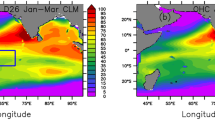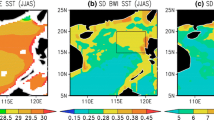Abstract
In this study, the temporal and spatial variations of observed global oceanic precipitation during 1979–2010 are investigated. It is found that the global trend in precipitation during this period varies at a rate of 1.5%/K of surface warming while the rate is 6.6%/K during 2006–2010. The precipitation is highly correlated with Sea Surface Temperature (SST) in both the temporal and the spatial patterns since the strong 1997–98 El Niño event. Considering the distributions of precipitation and SST, seven oceanic regions are classified and presented using the observed Global Precipitation Climatology Project (GPCP) data and Extended Reconstructed Sea Surface Temperatures, version 3 (ERSST.v3) data. Further examining the mechanisms of the classified oceanic precipitation regions is conducted using the Tropical Rainfall Measuring Mission (TRMM) satellite, GFDL-ESM-2G model precipitation and SST data and Hadley Center sea ice and SST version 1 (HadISST1) data. More than 85% of global oceanic precipitations are controlled by either one or both of the warmer-get-wetter mechanism and wet-get-wetter mechanism. It is estimated that a 0.5 SST signal-to-noise ratio, representing the trend of SST time series to the standard deviation, is a criterion to distinguish the mechanism of a region. When the SST ratio is larger than 0.5, the precipitation of this region is controlled by the warmer-get-wetter mechanism. SST, rather than the humidity, is the pivotal factor. On the other hand, when the SST ratio is less than 0.5, the precipitation is controlled by the wet-get-wetter mechanism. The SST variability is a significant factor contributing to the precipitation variation.
Similar content being viewed by others
References
Allan, R. P., and Soden, B. J., 2008. Atmospheric warming and the amplification of precipitation extremes. Science, 321(5895): 1481–1484.
Allen, M. R., and Ingram, W. J., 2002. Constraints on future changes in climate and the hydrologic cycle. Nature, 419(12): 224–232.
Chen, G., Chapron, B., Tournadre, J., Katsaros, K., and Vandemark, D., 1997. Global oceanic precipitation: A joint view by TOPEX and the TOPEX microwave radiometer. Journal of Geophysical Research, 102: 457–471.
Chen, G., Ma, J., Fang, C., and Han, Y., 2003. Global oceanic precipitation derived from TOPEX and TMR: Climatology and variability. Journal of Climate, 16: 3888–3904.
Chou, C., and Chen, C. A., 2010. Depth of convection and the weakening of tropical circulation in global warming. Journal of Climate, 23(11): 3019–3030.
Chou, C., and Neelin, J. D., 2004. Mechanisms of global warming impacts on reginoal tropical precipitation. Journal of Climate, 17: 2688–2614.
Chou, C., Neelin, J. D., Chen, C. A., and Tu, J. Y., 2009. Evaluating the ‘rich-get-richer’ mechanism in tropical precipitation change under global warming. Journal of Climate, 22(8): 1982–2005.
Du, Y., and Xie, S. P., 2008. Role of atmospheric adjustments in the tropical Indian Ocean warming during the 20th century in climate models. Geophysical Research Letters, 35(8), DOI: 10.1029/2008GL033631.
Held, I. M., and Soden, B. J., 2000. Water vapor feedback and global warming. Annual Review of Environment and Resources, 25: 441–475.
Held, I. M., and Soden, B. J., 2006. Robust responses of the hydrological cycle to global warming. Journal of Climate, 19: 5686–5616.
Huang, P., Xie, S.-P., Hu, K., Huang, G., and Huang, R., 2013. Patterns of the seasonal response of tropical rainfall to global warming. Nature Geoscience, DOI: 10.1038/NGEO1792.
John, V. O., Allan, R. P., and Soden, B. J., 2009. How robust are observed and simulated precipitation responses to tropical ocean warming? Geophysical Research Letters, 36, DOI: 10.1029/2009GL038276.
Liepert, B. G., and Previdi, M., 2009. Do models and obser-vations disagree on the rainfall response to global warming? Journal of Climate, 22(11): 3156–3166.
Meehl, G., Stocker, T., and Collins, W., 2007. Global climate projections. In: Climate Change 2007: The Physical Science Basis. Solomon et al., eds., Cambridge University Press, New York, 747–845.
Min, S. K., Zhang, X., Zwiers, F. W., and Hegerl, G. C., 2011. Human contribution to more-intense precipitation extremes. Nature, 470(7334): 378–381.
Mitchell, J. F. B., Wilson, C. A., and Cunnington, W. M., 1987. On CO2 climate sensitivity and model dependence of results. Quarterly Journal of the Royal Meteorological Society, 113: 293–322.
Muller, C. J., and O’Gorman, P. A., 2011. An energetic perspective on the regional response of precipitation to climate change. Nature Cliamte Change, 1: 266–271.
Neelin, J. D., Chou, C., and Su, H., 2003. Tropical drought regions in global warming and El Niño teleconnections. Geophysical Research Letters, 30(24): 2275.
Parry, M. L., Canziani, O. F., Palutikof, J. P., Linden, P. J., and Hanson, C. E., 2007. Climate Change 2007: Impacts, Adaptation and Vulnerability. Cambridge University Press, Cambridge, UK, 811–842.
Peterson, T. C., Zhang, X., and Brunet, I. M., 2008. Changes in North American extremes derived from daily weather data. Journal of Geophysical Research, 113, D07113.
Quartly, G. D., 2010. Improving the altimetric rain record from Jason-1 and Jason-2. Journal of Geophysical Research, 115(C3), DOI: 10.1029/2009JC005670.
Trenberth, K. E., Fasullo, J., and Smith, L., 2005. Trends and variability in column-integrated atmospheric water vapor. Climate Dynamics, 24(7–8): 741–758.
Tokinaga, H., Xie, S. P., Timmermann, A., McGregor, S., Ogata, T., Kubota, H., and Okumura, Y. M., 2012. Reginal patterns of tropical Indo-Pacific climate change: Evidence of the Walker Circulation weakening. Journal of Climate, 25: 1689–1710.
Wentz, F. J., and Schabel, M., 2000. Precise climate monitoring using complementary satellite data sets. Nature, 403: 414–416.
Wentz, F. J., Ricciardulli, L., Hilburn, K., and Mears, C., 2007. How much more rain will global warming bring? Science, 317(5835): 233–235.
Xie, S. P., Deser, C., Vecchi, G. A., Ma, J., Teng, H., and Wittenberg, A. T., 2010. Global warming pattern formation: Sea surface temperature and rainfall. Journal of Climate, 23(4): 966–986.
Author information
Authors and Affiliations
Corresponding author
Rights and permissions
About this article
Cite this article
Qian, C., Chen, G. Warmer-get-wetter or wet-get-wetter? A criterion to classify oceanic precipitation. J. Ocean Univ. China 13, 552–560 (2014). https://doi.org/10.1007/s11802-014-2160-1
Received:
Revised:
Accepted:
Published:
Issue Date:
DOI: https://doi.org/10.1007/s11802-014-2160-1




